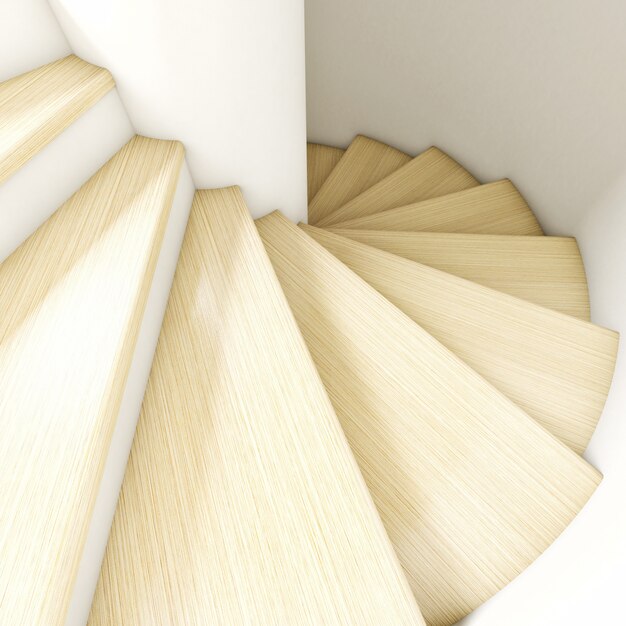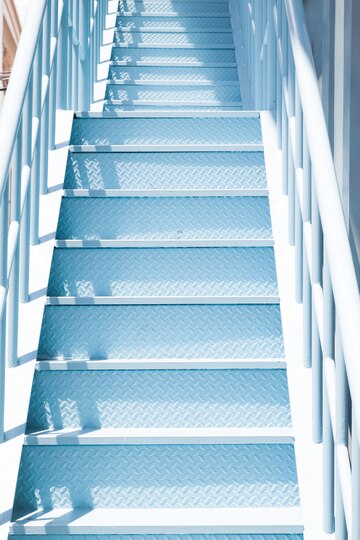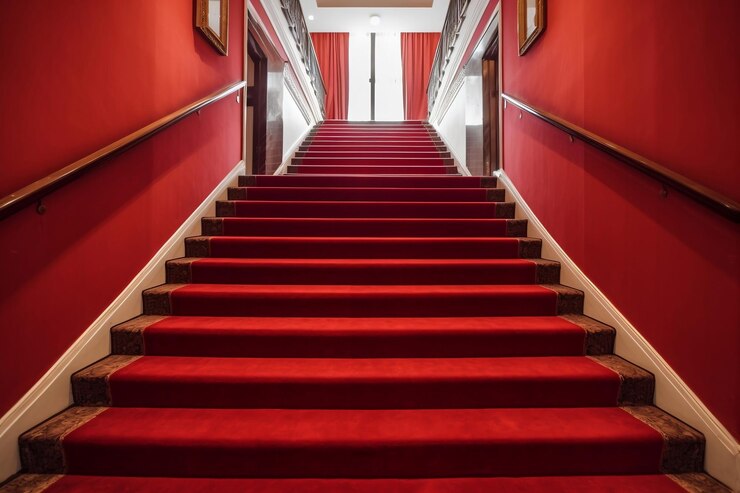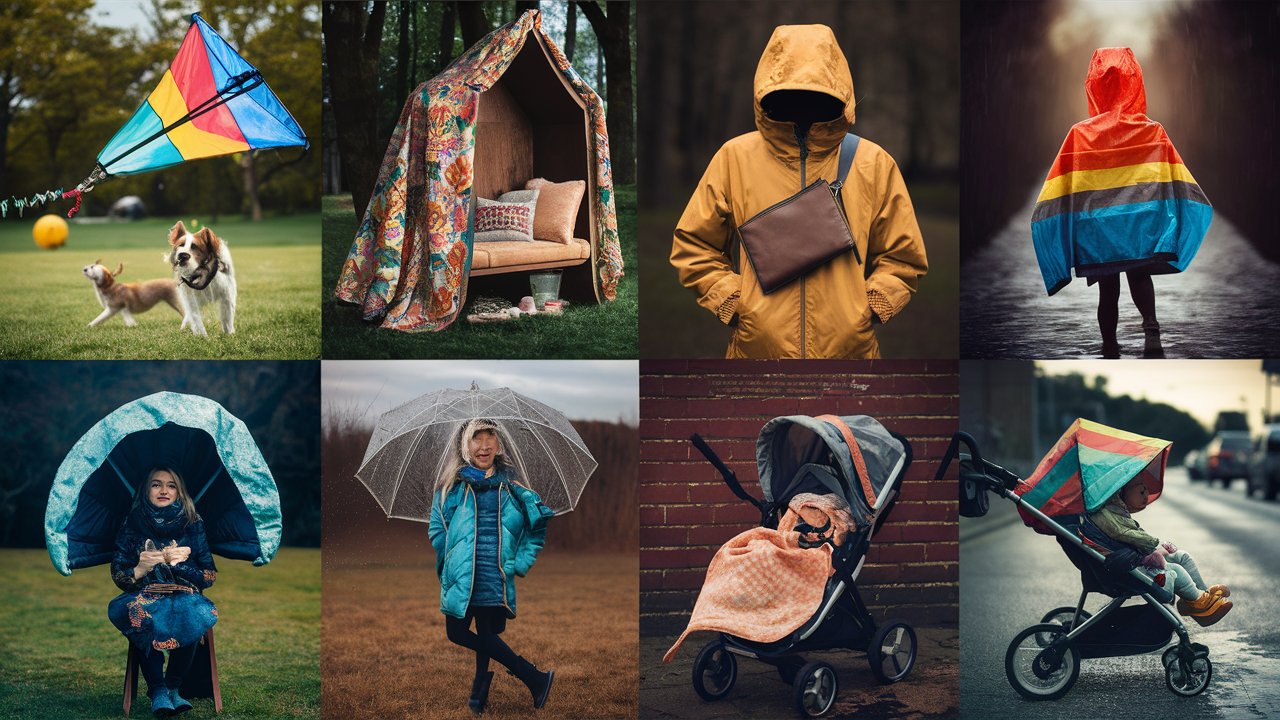Hard Surface Options:
- Hardwood: Classic and elegant, durable, easy to clean, adds value to your home. Cons: expensive, slippery, noisy.
- Luxury Vinyl Plank (LVP): Versatile and budget-friendly, waterproof, scratch-resistant, easy to install. Cons: not as luxurious as real wood, cold underfoot.
- Tile & Mosaic: Durable, water-resistant, unique and eye-catching. Cons: cold and hard, slippery, grout requires maintenance.
- Laminate Flooring: Cost-effective, easy to install, scratch-resistant. Cons: not as durable as real wood, can appear fake.
- Concrete: Industrial chic, durable, affordable. Cons: cold and hard, requires unique installation skills.
- Stone: Luxurious, durable, unique textures. Cons: expensive, heavy, requires professional installation.
Softer Options:
- Cork Treads & Risers: Sustainable, comfortable, sound-absorbing. Cons: not as durable as other options, prone to dents.
- Rubber Stair Treads: Anti-slip, durable, and good for outdoor stairs. Cons: not aesthetically pleasing, can be expensive.
- Sisal Rugs: Natural, durable, and affordable. Cons: can be rough underfoot, and requires regular cleaning.
Creative Options:
- Painted Stairs: Personalized touch, budget-friendly. Cons: requires skill and preparation, prone to wear and tear.
- Exposed Staircase: Industrial chic, minimal maintenance. Cons: requires well-maintained structural elements, not for all design styles.
- Runner Rugs: Adds color and warmth, and protects high-traffic areas. Cons: can bunch or slip, requires regular cleaning.
Considerations when choosing:
- Budget: Hardwood and tile are more expensive than LVP or laminate.
- Durability: Hardwood and tile are more durable than cork or rubber.
- Maintenance: Tile and laminate require less maintenance than carpet.
- Safety: Consider grip and traction for slippery surfaces.
- Style: Choose an option that complements your existing décor.
Remember, the best alternative for your stairs depends on your individual needs and preferences. Weigh the pros and cons of each option carefully and don’t hesitate to consult with a professional if you need help making a decision. There is another article I wrote about >>>>> Soft flooring alternatives to carpet that you should read to learn more about.
Ditch the Dowdy: Stepping Up Your Stair Game with Carpet Alternatives.
As a home improvement aficionado with 25 years under my belt, I’ve seen countless staircases adorned with the standard beige broadloom. While carpet offers warmth and sound dampening, let’s face it, it can be a dust magnet and prone to wear and tear, especially on high-traffic stairs.
But fear not, fellow design enthusiasts! There’s a world of exciting alternatives waiting to elevate your staircase from a functional necessity to a stunning focal point. Let’s delve into the top contenders, each offering unique aesthetics, practicality, and budget considerations.

Hardwood Stair Treads: Timeless Elegance with a Price Tag
Picture this: rich, honey-hued oak treads gleaming under soft lighting, exuding warmth and sophistication. Hardwood reigns supreme for those seeking a classic, timeless look. Its natural beauty adds instant value to your home, and its durability promises years of wear.
Plus, cleaning is a breeze – a quick sweep and occasional damp mop is all it takes. However, be prepared for a heftier investment compared to other options. Hardwood can also be slippery, especially when wet, and the clatter of footsteps might not please downstairs neighbors. There is another article I wrote about >>>> Soft flooring alternatives to carpet to learn more.
Luxury Vinyl Plank (LVP): Budget-Friendly Versatility That Mimics the Best.
If hardwood’s price tag makes your wallet wince, fear not! LVP offers a budget-conscious alternative that mimics the look of wood, stone, or even tile with astonishing realism. Its waterproof and scratch-resistant surface is ideal for busy households with pets or little ones.
Installation is a breeze compared to real wood, making it a DIY-friendly option. However, while LVP boasts impressive durability, it can’t quite match the longevity of real wood. And while its texture often mimics natural materials, it can’t replicate the warmth and tactile experience of the real deal.
Tile & Mosaic: Unleash Your Inner Artist with Bold Statements.
Craving a showstopper staircase that reflects your unique personality? Look no further than tile and mosaic! This option explodes with design possibilities, from sleek subway tiles to vibrant hand-painted mosaics. You can create intricate patterns, incorporate pops of color, or even tell a story through your tile choices.
The tile’s durability and water resistance make it ideal for high-traffic areas and messy spills. However, keep in mind that tile can be cold and hard underfoot, and grout lines require regular maintenance to prevent staining. Additionally, the installation process can be complex and best left to professionals.
Cork Treads & Risers: Sustainable Comfort Beneath Every Step.
For those seeking an eco-friendly option that prioritizes comfort and sound absorption, cork is a delightful choice. This natural material provides a soft, springy surface that’s gentle on your joints and pleasantly quiet underfoot.

Cork boasts an impressive grip, making it a safe choice for families with young children or pets. Plus, its natural antimicrobial properties make it a hygienic option. However, cork’s softness comes at a cost – it’s more prone to dents and scratches compared to harder materials. And while its warm, honey-hued appearance is naturally beautiful, it might not suit every design aesthetic.
Laminate Flooring: Affordability Meets Diverse Wood and Stone Looks.
Laminate flooring offers a budget-friendly solution for mimicking the look of expensive hardwoods and stones. Its scratch-resistant surface makes it ideal for busy households, and its easy-to-clean nature is a win for those short on time. Installation is relatively straightforward, making it a DIY-worthy option for the handy homeowner.
However, laminate’s durability pales in comparison to real wood, and its synthetic composition can give away its budget-friendly roots upon closer inspection. Additionally, laminate can be noisy underfoot and can feel cold in cooler climates.
Remember, the best alternative for your staircase is the one that aligns with your budget, design preferences, and lifestyle needs. Weigh the pros and cons of each option carefully, and don’t hesitate to consult with a professional if you need help navigating the choices.
With a little planning and creativity, you can transform your staircase from a mundane passageway into a stunning statement piece that reflects your unique style. So, ditch the dowdy carpet and embrace the possibilities! Your perfect staircase awaits, ready to take your home’s design to the next level.
Part 2: Mixing and Matching: Design Dilemmas Solved.
Stepping beyond the material itself, let’s explore creative ways to incorporate these alternatives into your staircase design, solving common dilemmas and adding a touch of personality.
Runner Rugs – Soft Landings on a Hard Climb.
For those who still crave the warmth and softness of carpet underfoot but want to avoid wall-to-wall carpeting, runner rugs offer the perfect compromise. They add a pop of color or pattern while protecting the high-traffic areas of the treads.
Opt for plush wool runners for maximum comfort, or choose durable sisal rugs for a more casual vibe. Just ensure your chosen rug has a non-slip backing to prevent slips and tumbles.
Painted Stairs – Unleash Your Inner Monet.
If your budget or DIY spirit doesn’t stretch to new materials, consider transforming your existing staircase with a splash of paint. This option allows you to unleash your inner artist and create a truly unique focal point.

Play with bold stripes, geometric patterns, or even ombre fades for a modern touch. Alternatively, embrace a rustic charm with distressed wood grain effects. Remember, proper preparation is key for a lasting finish. Sand, prime, and choose a high-quality paint suitable for stair traffic.
Exposed Staircase – Industrial Chic with Raw Materials.
For those who love a modern, industrial aesthetic, embracing the raw beauty of exposed stairs can be a bold and dramatic choice. This option works best with minimalist interiors and requires minimal maintenance.
Simply ensure the structural elements are sound and aesthetically pleasing. Enhance the look with sleek metal railings or contrasting paint on the risers for added visual interest.
Remember, when mixing and matching these options, consider the overall balance of your design. Choose complementary colors and textures that harmonize with your existing décor. Don’t be afraid to experiment, but maintain a sense of cohesion for a stylish and unified look.
With a little creativity, you can transform your staircase from a purely functional element into a stunning work of art, reflecting your unique style and personality.
Let’s move on to Part 3: Pro Tips for Perfect Steps to ensure your staircase makeover is not only beautiful but also safe and functional.
Part 3: Pro Tips for Perfect Steps.
Now that you’ve chosen your ideal material and explored creative design options, let’s delve into the essential tips to ensure your staircase renovation is a resounding success.
Safety First: Prioritizing Grip, Traction, and Lighting.
Safety should always be paramount when navigating stairs, especially for young children and elderly individuals. Here are some key considerations:
- Grip and Traction: Opt for materials with inherent grip, like textured wood or cork, or add non-slip treads to slippery surfaces like tile or laminate.
- Adequate Lighting: Ensure proper lighting at the top and bottom of the stairs, as well as along the sides, to prevent missteps and falls. Consider motion-sensor lights for added convenience.
- Railings and Banisters: Install sturdy railings or banisters on both sides of the staircase, especially if there are young children or elderly individuals in the household.
Maintenance Matters: Choose Materials That Suit Your Lifestyle.
The ideal stair material should complement your lifestyle and cleaning routine. Consider these factors:
- High-Traffic Areas: If your stairs see a lot of activity, choose durable materials like hardwood, LVP, or tile that can withstand daily wear and tear.
- Pets and Messy Spills: If you have furry companions or a penchant for clumsiness, opt for waterproof and stain-resistant materials like LVP, tile, or laminate.
- Cleaning Ease: Consider your cleaning routine and choose materials that are easy to maintain. Hardwood and cork require simple sweeping and mopping, while tile and laminate might need additional grout cleaning.
Budgeting Bonanza: Compare Costs and Prioritize Based on Your Needs.
Staircase renovations can vary significantly in cost. Here’s a rough breakdown to help you plan:
- High-End: Hardwood, custom tilework, and intricate mosaics can be the most expensive options.
- Mid-Range: LVP, laminate, and cork offer a good balance of affordability and durability.
- Budget-Friendly: Runner rugs and painted stairs are the most cost-effective options, although they might require more frequent maintenance.
Remember, prioritizing your needs and setting a realistic budget will help you make informed decisions and avoid unexpected expenses.
By following these pro tips, you can ensure your staircase renovation is not only aesthetically pleasing but also safe, functional, and budget-friendly. Now, let’s explore some highly relevant questions you might have about alternative stair coverings.
Part 4: Q&As.
Now that we’ve covered the exciting world of alternative stair coverings, let’s address some burning questions you might have:
1. What are the best alternatives to carpets for stairs with pets?
Pets can be tough on stairs, with their claws scratching wood and accidents staining fabrics. Here are some top pet-friendly options:
- LVP: Durable, waterproof, and scratch-resistant, LVP is a fantastic choice for busy households with furry friends. Choose a textured variety for added grip to prevent slips.
- Tile: Ceramic or porcelain tiles are another great option, being highly durable and easy to clean up after pet messes. Opt for matte or textured finishes for better grip.
- Cork: Soft and comfortable underfoot, the cork naturally repels moisture and stains, making it ideal for pet accidents. However, its softer nature makes it more susceptible to claw marks.
2. Can I install stair runners over the existing carpet?
Yes, in most cases, you can install stair runners over existing carpets. This is a budget-friendly way to add a touch of color, pattern, and warmth to your staircase without removing the old carpet. However, ensure the existing carpet is in good condition, free of major wear and tear, and flat enough for the runner to sit evenly.
3. How much does it cost to replace carpet with hardwood stairs?
The cost of replacing carpet with hardwood stairs can vary significantly depending on the type of wood, the complexity of the staircase, and local labor rates. Generally, expect to pay anywhere from $10 to $25 per square foot of material and installation. This can quickly add up on larger staircases, so factor in your budget carefully.
4. Are there DIY-friendly options for updating my staircase?
Absolutely! Several options are perfect for the DIY enthusiast:
- Painting stairs: A fresh coat of paint can dramatically transform your staircase. Choose a durable paint suitable for stair traffic and prepare the surface properly for a lasting finish.
- Installing LVP: Many LVP varieties come with click-lock installation systems, making them straightforward to lay even for beginners. Just ensure you have the proper tools and follow the manufacturer’s instructions carefully.
- Adding runner rugs: This is a simple and budget-friendly way to update your stairs without major renovations. Choose a non-slip backing to prevent accidents and ensure the runner lays flat and secure.
5. What are some creative ways to decorate bare stairs?
Bare stairs offer a blank canvas for your creativity. Here are some ideas:
- Stencil patterns or quotes on the risers.
- Hang artwork or family photos along the walls.
- Create a gallery wall with framed prints or mirrors.
- String fairy lights for a touch of whimsy.
- Place potted plants or vases on the landings.
Remember, the key is to choose options that complement your existing décor and reflect your personal style.
By choosing the right alternative stair covering and incorporating these helpful tips and creative ideas, you can transform your staircase from a mere passageway into a stunning and functional focal point of your home. So, ditch the dowdy carpet and embrace the endless possibilities!
I am commitment to crafting compelling narratives and delivering insightful content continues to inspire and inform readers across various platforms. Explore her articles on AlternativesZone.com and FactAfterFact.com to experience a rich tapestry of knowledge and discovery. Here I Analyze and Test the products and services together with my team before we recommend them to our users. Nice Reading Here!











